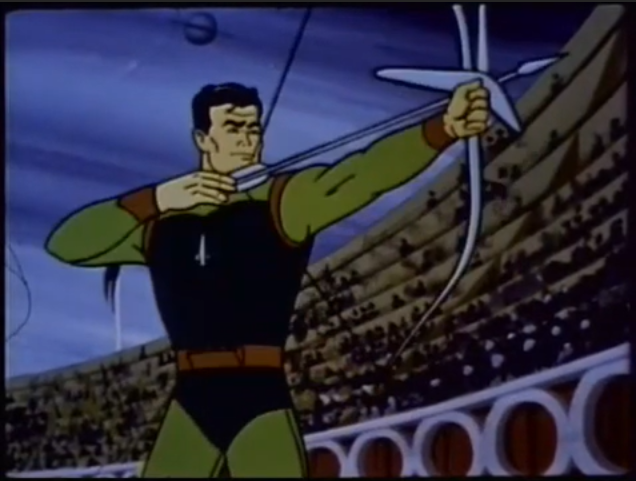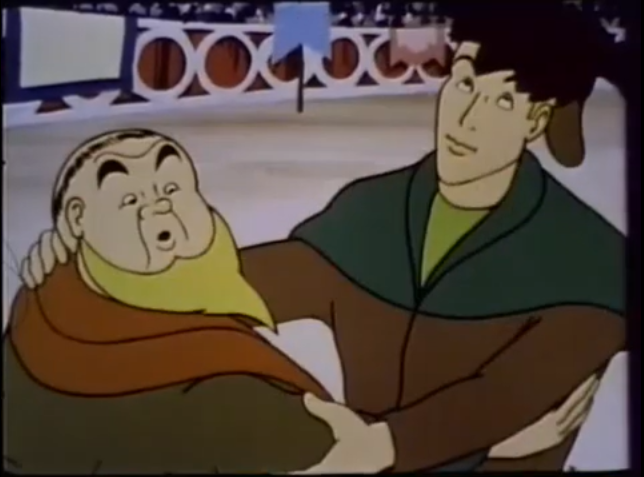
It’s the mid-sixties, and everyone has the future and space exploration on their minds—if you’re making Saturday morning cartoons, you want to tap into that zeitgeist to get viewers and sell cereal. What would be the most obvious way of getting those space bucks? You make a series based on Flash Gordon or Buck Rogers, of course. What do you do if you don’t have the money to get the license to either? Apparently, you stick a jetpack on Robin Hood and see where that takes you.
Produced by Canadian animation house Krantz Films between 1966 and 1969, Rocket Robin Hood lives up to the standard of many Canadian entertainment products by coming off as inherently less impressive than everything surrounding it. Fifty years removed and with a higher appreciation for camp, the idea of combining the characters from the Robin Hood stories with a science fiction setting is silly enough to be appreciated on some levels, but I can imagine that this show was considered hokey even back in the sixties. The choice of premise seems to come from the same mindset that keeps certain characters and genres alive well after their expiration date: “well, I liked this kind of story as a kid, so CLEARLY kids today still care about it”—just gussy it up with some “contemporary” trappings, and you’re seemingly good to go (the irony is that the kids being subjected to Rocket Robin Hood would, in turn, grow up to be the adults who would subject kids of my generation to new versions of, say, The Flintstones.) The thing is, when a kid at the height of the space race craved something futuristic, they probably preferred just having the space ships and robots without medieval tunics (no, they never mention where their air comes from or how they can live in space for more than zero seconds) and longbows and lute music haphazardly inserted into it.

It likely didn’t help that the show goes out of its way to spell out of how very much IN SPACE it takes place. The primary cast consists of Robin and his Merry Men, more or less taken directly from all the older stories (although I don’t know where in the text it says that Maid Marian doesn’t wear pants), but they live on “New Sherwood Forest Asteroid” (which is only real referred to as such in the intro, with the actual dialogue preferring the much more sensible “Sherwood Asteroid”), wield “electro-quarterstaffs”, and battle against Prince John and the “Sheriff of N.O.T.T.”—by the time they started talking about villains “quivering in their space-boots” or “space jousting” (it’s just regular jousting with robot horses! It’s not that different!) I had enough of it, although the intro line “robs from the cosmic rich to give to the astro-poor” was so absurd as to get a legitimate laugh out of me. It’s trying so hard to get you to accept the mash-up—and running up against it more often than not, such as when characters are surprised when their arrows don’t work on robots, and then just switch to lasers or other gadgets—but it mostly just makes you question why they bothered in the first place.

Like the designs, the characterizations are mostly in line with how the characters have been portrayed in more traditional incarnations (they say that these are the 30th century descendants of those characters, but that just raises further questions)—Little John, Will Scarlet, and Friar Tuck once again being the most prominent supporting players here, although there’s also a geriatric chef character added for “comic relief”—but one big problem is Robin Hood himself. The narration calls him things like “the happy outlaw”, but despite a few one-liners from him per episode, in personality and design he really comes off as the sort of square-jawed, hyper-competent leading man of the pulps, more of a Doc Savage type than a cunning and dashing Errol Flynn figure, which is what most people associate with Robin Hood. Again, it makes it seem like they just put a medieval aesthetic on a standard two-fisted Buck Rogers kind of story. As well, in the sampling of episodes I watched (out of over fifty, to be fair), Robin and the Merry Men don’t seem to do, well, Robin Hood-type things all that often (as in, rob from the cosmic rich and give to the astro-poor), and mostly get involuntarily pulled into situations involving a myriad of standard futuristic supervillains (one of them is even called Ming! How shameless can you get?) These are supposed to be some of the most anti-authoritarian and proactive heroes in the western canon, but you wouldn’t get that idea from seeing them here—instead, it’s basically your average superhero fare (and the fact that Robin Hood seems to have the tacit approval of the Space UN in some episodes kinda goes against the whole “outlaw” idea, doesn’t it?) One of the episodes I watched featured a team-up of what I presume are recurring antagonists—with dopey names like Baron Blank, Mr. Cool, and Laser—but I much prefer my imagined scenario where those goons have never been seen or mentioned before and they just hope we don’t notice. Sometimes, you have to create your own fun.

So, yes, Rocket Robin Hood relies heavily on cheap storytelling tricks, but would you believe it also relies on cheap animation tricks, too? It’s the sixties, of course, so no cartoons on television had any budgets whatsoever, and when you watch them now it’s mostly just to see in what ways they managed to cheat out of actually having to animate anything. As was the style at the time, this show reuses a lot of poses and animation (they certainly love their one explosion effect), includes plenty of static shots or stilted movement, and otherwise utilizes the tools of the limited animation trade—but just like Robin himself, it has a few tricks up its sleeves as well. Throughout a standard twenty-odd minute episode, you will see three or four opening sequences with their own songs, a collection of vignettes explaining the setting or the characters that they can reuse episode after episode, and each of the three acts not only have their own title card, but begin with a recap of the previous segment…yes, a recap of what you had watched all of two minutes ago, before the commercials. If that’s not dedication to the art of avoiding having to make an actual cartoon, I don’t know what is.

It also has a tendency towards promising exciting things and not delivering on them. In one episode where Robin and Maid Marian are stranded on the spooky horror asteroid, they meet a villain who might as well be named Dr. Acula (whose plot is to somehow convince Robin to help him destroy the sun) with a henchman who is clearly meant to be a werewolf, but because this show is cheaply-made, he instead turns into…the same guy, but he growls a lot. That same episode also repeatedly teases a fight with a giant robot bat that never happens. Riveting stuff.

Despite all that, some later episodes of the show utilize more abstract hand painted backgrounds that give space scenes an appropriate-for-the-time psychedelic vibe, and may even feature a decently striking image or two (just an image, though, never an animation) that bring to mind the comic books of the era (maybe this would have been better as one?) Apparently these were the seasons where Krantz outsourced the show to a studio run by future maverick animator Ralph Bakshi, and despite maintaining the overall chintzy production values, I can’t say that they have absolutely no artistic merit. A good example of this is in the episode “Dementia Five”, which is probably the one I saw that was the closest to being interesting—it takes the abstract painting aspect and runs with it, has a fairly cool-looking antagonist, and has some decent swerves, like the sudden realization that the exposition-spouting alien we’d been following for five minutes was actually the size of a plum. Of course, once Robin Hood and Little John actually enter the mind-bending other-dimension we had heard so much about, the most surreal things they can come up with are a slightly twisty staircase, a picture of a cat being mixed into a bunch of quick cuts, and snakes—and by the end, Robin has apparently figured out the secret that took an entire alien civilization’s best scientists to crack, and can thus soundly defeat a villain who we previously saw annihilate an entire galaxy with his mind. Can’t have too much tension, after all.


(Oddest discovery: there’s an indy band/album based entirely on this episode)
Apparently, Krantz and Bakshi also saw something in “Dementia Five” as well, because when they took over the sixties Spider-Man series (a true camp cartoon classic), they ended up reusing that entire episode (as well as at least one other one) and simply replaced the Rocket Robin Hood characters with Spider-Man. As in, they reused the entire finished animation and voices and everything. I’ve seen a lot of impressively thrifty cost-cutting measures in the history of television cartoons, but that might actually be most egregiously cheap. I guess if there’s one big thing I can give to Rocket Robin Hood, it’s that it makes for a good fun fact about Spider-Man.
(Another direct connection: Friar Tuck is voiced by Paul Kligman, who also played J. Jonah Jameson.)

I can’t say I particularly hated watching Rocket Robin Hood—certainly it’s no better or worse than The Beatles, the other sixties cartoon I watched for this project—and part of me still appreciates the overall silliness of the premise, which feels naively old-fashioned in a way that’s almost charming. But I also have to look at it in the context of when it was made, and that it was far from the only space-themed adventure cartoon on TV at the same—and what reason did any kid have to choose it over something like Space Ghost, which wasn’t necessarily a better written or animated show, but sure looked a heck of a lot cooler? It’s ultimately a fairly anonymous piece of television filler, whose unwavering commitment to combining two different aesthetics gives it some kitsch value over half a century later, but seems like it was always meant to be sort of ignored.
BUT, IS THE THEME SONG CATCHY?: Like I said, it has about three or four different theme songs, most of which fall into that chorus style that I just automatically associate with the squarer part of the sixties, although the primary intro does have a faux-medieval ballad which sometimes segues into licks from a rock guitar, so that’s all right I guess.
